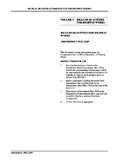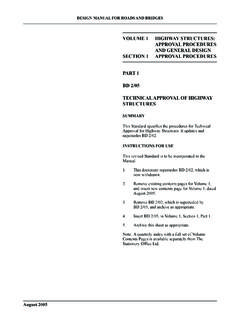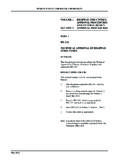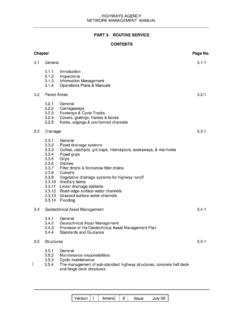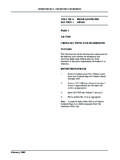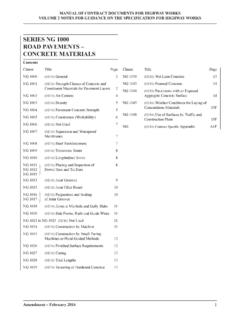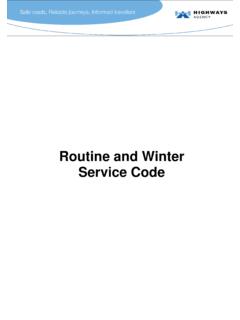Transcription of DMRB VOLUME 4 SECTION 1 - Standards for Highways
1 VOLUME 4 geotechnics and drainage SECTION 1 earthworksPart 8ha 120/08guidance on the trenchless installation of services beneath motorways and trunk roadssummaryThis Advice Note provides guidance on the use of trenchless installation techniques for small diameter service tunnels and ducts beneath motorways and trunk roads. It addresses the assessment, review and risk management of such for use1. This documents supersedes HA 120 Remove Contents Pages for VOLUME Insert new Contents Pages for VOLUME 4 dated August Remove HA 120/07 from VOLUME 4, SECTION 1, Part Insert HA 120/08 into VOLUME 4, SECTION 1, Part Archive this sheet as : A quarterly index with a full set of VOLUME Contents Pages is available separately from The Stationery Office manual for roads and bridgesaugust 2008design manual for roads and bridgesha 120/08 VOLUME 4, SECTION 1, Part 8the Highways agencyscottish government welsh assembly government llywodraeth cynulliad cymruthe dePartment for regional develoPment northern irelandGuidance on the trenchless installation of services beneath Motorways and Trunk RoadsSummary.
2 This Advice Note provides guidance on the use of trenchless installation techniques for small diameter service tunnels and ducts beneath motorways and trunk roads. It addresses the assessment, review and risk management of such 2008volume 4 SECTION 1 Part 8 ha 120/08registration of amendmentsamend noPage nosignature & date of incorporation of amendmentsamend noPage nosignature & date of incorporation of amendments registration of amendmentsaugust 2008volume 4 SECTION 1 Part 8 ha 120/08registration of amendmentsamend noPage nosignature & date of incorporation of amendmentsamend noPage nosignature & date of incorporation of amendments registration of amendmentsvolume 4 geotechnics and drainage SECTION 1 earthworksPart 8ha 120/08guidance on the trenchless installation of services beneath motorways and trunk roadscontentsChapter1.
3 Introduction2. trenchless Technology Methods3. Managing the Risks Associated with trenchless Methods4. Responsibilities Under the New Roads and Streetworks Act 1991 and the Traffic Management Act 20045. Indentification and Location of Existing Underground Plant and Facilities6. Method Statements and Emergency Procedures7. Managing Geotechnical Risk8. Monitoring and Records to be Kept During Construction9. Post Construction Records10. Health and Safety Aspects of trenchless Crossings11. References12. EnquiriesAppendix A Definitionsdesign manual for roads and bridgesaugust 2008august 2008volume 4 SECTION 1 Part 8 ha 120/081. This Advice Note provides guidance on the assessment, review and risk management of the trenchless installation of small diameter service tunnels and ducts beneath motorways and trunk roads.
4 The use of trenchless technology is increasing due to improved techniques and the majority of utility companies now encourage the use of trenchless methods. Although historically only used for motorway crossings their use is currently becoming more common on other trunk road Where an installation needs to cross the width of the carriageway, trenchless methods offer particular advantages over traditional techniques of open trench excavation. These include minimising disruption to the operation of the network and reduction of the requirement for traffic This Advice Note is issued for the guidance of personnel responsible for the assessment and co-ordination of trenchless construction proposals. It looks at procedures to minimise geotechnical and operational risk to the network.
5 Particular attention is given to the information to be provided by the It principally covers projects procured by a Statutory Undertaker or other third party, although may also be applied where the Overseeing Organisation is procuring the project. The use of trenchless technology is also covered in SD 14 (MCHW ) but this only relates to schemes procured by the Overseeing This Advice Note covers the installation of new pipes with internal diameters up to and including 2,000 mm. Pipes and conduits in excess of 2,000 mm internal diameter require technical approval, the procedure for which is set out in BD 2/05 (DMRB ). The replacement of existing pipes is specifically omitted. The guidance is applicable to all Trunk Roads and may also be considered good practice on other trenchless technology and Definitions relating to this advice note are included in Appendix 1 introductionaugust 2008volume 4 SECTION 1 Part 8 ha 120/082.
6 trenchless technology trenchless technology covers a range of techniques for constructing crossings beneath motorways and trunk roads without excavation of the carriageway. The methods used must be suitable for creating a stable bore of the required diameter inside which a utility service is This advice note aims to provide general guidance on the use and limitations of the various trenchless methods and systems. Since these are constantly improving and developing, it is recommended that reference be made to the United Kingdom Society for trenchless Technology (UK STT) website where further guidance and information is freely available. Pipe Jacking and microtunnelling Pipe jacking is a method by which pipes or sleeves are installed by being pushed through the ground behind a small, steerable, remotely controlled, tunnel boring or micro tunnel machine.
7 This technique is called microtunnelling and pipes and sleeves can be installed to very strict tolerances in line and level. This makes them not just suitable for gravity mains, but also minimises any risk from lack of alignment control where close tolerances are needed and expected, such as under trunk roads and Microtunnelling machines generally start in the UK at 600 mm internal diameter although smaller sizes down to 300 mm internal diameter can be obtained from overseas suppliers. The maximum size of what is generally regarded as a microtunnelling machine is approximately 1,500 mm internal diameter. Above this size, tunnelling machines are regarded as Tunnel Boring Machines (TBMs). Concrete jacking pipes are supplied in sizes up to m internal diameter. Whilst concrete jacking pipes can be supplied in smaller sizes, clay, steel and fibre-reinforced pipes are more often used in these applications.
8 Polymer pipes are becoming increasingly popular for their strength and corrosion resistance Minimum diameters are also controlled by safety considerations. BS 6164 Code of practice for safety in tunnelling in the construction industry SECTION , states that for small tunnels, the internal size for man-entry should not be less than m high by m wide. This limits the size of circular man-entry tunnels to m internal diameter. Whilst it is recognised that the excavating space at the front of the tunnel may be slightly larger than the internal diameter of the finished tunnel it is generally accepted that the minimum size refers to the whole tunnel consistent with access and egress in emergency The use of hand-excavation open pipe-jacking shields is now unacceptable as a trenchless crossing method.
9 This has arisen since the introduction of the Control of Vibration at Work Regulations 2005 (CoVAWRs) which aims to manage the risk to operatives of hand-arm Vibration Syndrome (HAVS) or the more commonly known Vibration White Finger (VWF). In Northern Ireland refer to The Control of Vibration at Work Regulations (Northern Ireland) Commonly used hand controlled equipment used in excavating tunnels have high vibration levels and can only be used for a matter of a few minutes before the operative reaches the maximum daily vibration level of exposure. Consequently, hand excavation using vibrating tools should be reduced and managed or preferably eliminated as a working practice. Most micro-tunnels are straight but specialist surveying equipment and short length pipes can be provided to allow some curved tunnels to be excavated and There are two types of micro-tunnelling machine, the open-faced auger and the closed-face slurry machine.
10 The open-faced or Decon machine uses a front cutting disc, which is driven by a continuous flight auger string from the shaft bottom. As the cutting disc rotates, the cut material is removed along the tunnel by the auger to the shaft bottom for disposal. The ground conditions have to be such that the material can be transported effectively by the screw at a steady rate. Water logged ground unless pre-treated can inundate the face and flood the screw, with consequential ground loss causing major surface settlements. Due to the length of the driving auger the maximum length of this type of micro tunnel is about 100 m but can be much less in very stiff clay with cobbles where the torque on the auger can become 2 trenchless technology methodsaugust 2008volume 4 SECTION 1 Part 8 ha 120/082/2chapter 2 trenchless technology The closed-face slurry machine has a sealed bulkhead in the head of the machine through which slurry is pumped at sufficient pressure to stabilise any loose ground and to balance any water pressure.

